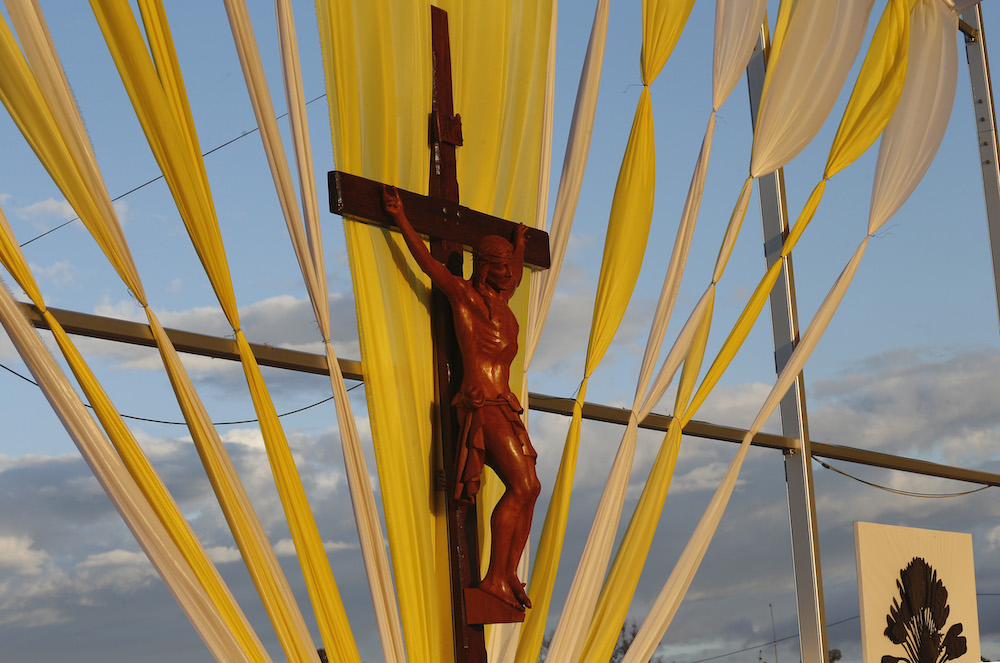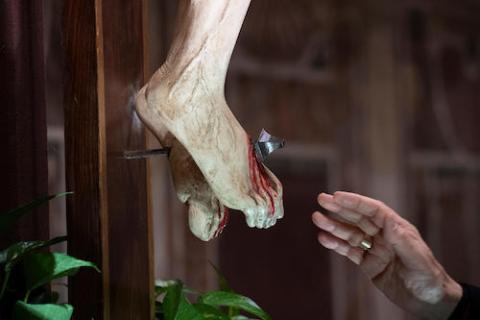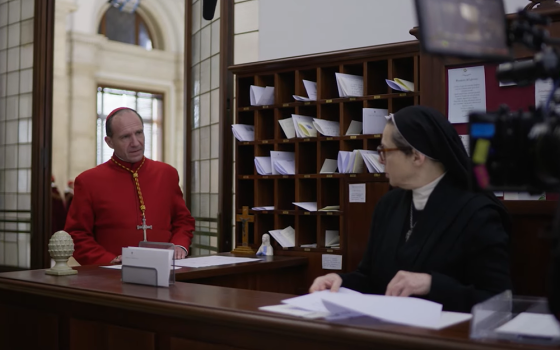
A crucifix is pictured onstage before the start of Pope Francis' vigil with young people at the Soamandrakizay diocesan field in Antananarivo, Madagascar, Sept. 7, 2019. (CNS/Paul Haring)
Yesterday, I began my look back at H. Richard Niebuhr's Christ and Culture, explaining why I reread the book and considering the first resolution of the problem of Christ and culture that Niebuhr puts forward, the Christ-against-culture stance adhered to by those he calls "radical" or "exclusive" Christians.
Today, I will look at Niebuhr's examination of the position held by those who posit a Christ-of-culture stance as the preferred solution to the problem. In Niebuhr's time, this position had characterized liberal Protestantism in the late 19th and first half of the 20th century, but it was coming in for a great deal of criticism from the neo-orthodox movement associated with Karl Barth and born of the carnage of World War I. For us Catholics, the Christ-of-culture school is most recognizable as the post-conciliar experiment in liberal Catholicism, and it would not be going too far to say NCR has itself been one of the chief repositories of the writings of those who advocate this resolution to the difficulty.
Yet, as we saw yesterday with the Christ-against-culture option, it is a mistake to associate these options vis-à-vis the culture with any particular ideological stance. Just as there are culture warriors on both the left and the right, there are accommodationists to culture on both ideological poles as well.
As I mentioned yesterday, bear with me as I share some long block quotes. They are worth reading in part because of the strength of the writing but also because he captures nuances that would turn any summarization into a form of simplification and that is the last thing this complex topic needs.
In describing the Christ-of-culture position, Niebuhr begins:
In every culture to which the Gospel comes there are men who hail Jesus as the Messiah of their society, the fulfiller of its hopes and aspirations, the perfecter of its true faith, the source of its holiest spirit. In the Christian community they seem to stand in direct opposition to the radicals, who reject the social institutions for Christ's sake. … They feel no great tension between church and world, the social laws and the Gospel, the workings of divine grace and human effort, the ethics of salvation and the ethics of social conservation or progress. On the one hand they interpret culture through Christ, regarding those elements in it as most important which are most accordant with his work and person; on the other hand they understand Christ through culture, selecting from his teaching and action as well as from the Christian doctrine about him such points as seem to agree with what is best in civilization. (p. 83)
There is, I suppose, a tendency in all of us to cherry pick from Scripture and tradition to bolster our positions, just as there is a temptation to elide or omit entirely those parts of the New Testament witness which might cause embarrassment in sophisticated company. That such tendencies and temptations are what lead us astray is so obvious that it barely warrants a mention, and so, unmentioned, it becomes easier to forget. And off the path we go.
Niebuhr can be cutting as well as preceptive:
Though their fundamental interest may be this-worldly, they do not reject otherworldliness; but seek to understand the transcendent realm as continuous in time or character with the present life. Hence the great work of Christ may be conceived as the training of men in their present social existence for the better life to come; often he is regarded as the great educator, sometimes as the great philosopher or reformer. … Such Christians have been described psychologically by F.W. Newman and William James as constituting the company of the "once-born" and the "healthy-minded." (p. 84)
I confess I laughed out loud when I encountered "once-born." But this is more than funny. The attempt to understand the transcendent in horizontal terms is, from one perspective, necessary: If faith remains pie-in-the-sky, it will become irrelevant over time. Those who adhere to the Christ-of-culture stance are more likely to display effectiveness even while heroic faith is not for them. (If only success was a name of God!) The more prosaic danger is this: how easily this attempt to tailor religion to the circumstances of our time and place ends up omitting the uncomfortable, the difficult, that which calls us to conversion and so is what we may most need to hear and to profess.
As in the case of the radical Christian, Niebuhr looks back into history for examples of the Christ-of-culture stance. The Gnostics are one example, but so, too, were those who turned to the categories of Hellenistic thought to make sense of mysteries like the Holy Trinity. Niebuhr is suspicious of the characterization of the Middle Ages as a time of Christian civilization, if by that term we mean that all of its adherents saw Christ as the fulfillment of their culture. Indeed he thinks the full flowering of this position came much later:
In medieval culture, Abelard was a relatively lonely figure; but since the 18th century his followers have been numerous and what was heresy became the new orthodoxy. A thousand variations of the Christ-of-culture theme have been formulated by great and little thinkers in the Western world, by leaders of society and of the church, by theologians and philosophers. It appears in rationalistic and romantic, in conservative and liberal versions. Lutherans, Calvinists, sectarians, and Roman Catholics produce their own forms. From the point of view of our problem, the catchwords "rationalism," "liberalism," "fundamentalism," etc., are not highly significant. They indicate what lines of division there are within a cultural society, but obscure the fundamental unity that obtains among men who interpret Christ as a hero of manifold culture. (p.91)
Again, Niebuhr is asking us to look beyond the categories of religious identification that we usually employ to see commonalities — and differences — beyond. The liberal and the fundamentalist are both capable of seeing Christ as the fulfiller of their cultural hopes, indeed of seeing in Christ the epitome of the cultural ideal they hold.
Advertisement
Amongst other things, the Christ-of-culture school is likely to cooperate in the reduction of religion to ethics. Whose ethics is less important than the reduction:
Thomas Jefferson is one of the group. "I am a Christian," he declared, "in the only sense in which he [Jesus Christ] wished any one to be," but he made that declaration after he had carefully excerpted from the New Testament the sayings of Jesus which commended themselves to him. … The philosophers, statesmen, reformers, poets, and novelists who acclaim Christ with Jefferson all repeat the same theme: Jesus Christ is the great enlightener, the great teacher, the one who directs all men in culture to the attainment of wisdom, moral perfection, and peace. Sometimes he is hailed as the great utilitarian, sometimes as the great idealist, sometimes as the man of reason, sometimes as the man of sentiment. But whatever the categories are by means of which he is understood, the things for which he stands are fundamentally the same — a powerful, co-operative society achieved by moral training. … Many of the leading theologians of the church in the nineteenth century joined the movement. … Christ is in this presentation less the Jesus Christ of the New Testament than the principle of mediation between finite and infinite. Christ belongs in culture, because culture itself, without "sense and taste for the infinite," without a "holy music" accompanying all its work, becomes sterile and corrupt. This Christ of religion does not call upon men to leave homes and kindred for his sake; he enters into their homes and all their associations as the gracious presence which adds an aura of infinite meaning to all temporal tasks. (pp. 91-93)
Setting aside Jefferson's flagrant pride, let us be honest: we have had these conversations, we have argued that Christ "makes sense," that the world is better off by his example, that he is the infinite extension of our finite hopes and deeds. We have, when needed, invoked someone other than "the Jesus Christ of the New Testament."
How far the distortions go, of both the nature of Christ and the nature of man, is in direct inverted proportion to the cogency with which they are brought to bear and the neatness of the solutions they achieve:
Back of all these Christologies and doctrines of salvation is a common notion that is part of the generally accepted and unquestioned climate of opinion. It is the idea that the human situation is fundamentally characterized by man's conflict with nature. Man the moral being, the intellectual spirit, confronts impersonal natural forces, mostly outside himself but partly within him. … That man's fundamental situation is not one of conflict with nature but with God, and that Jesus Christ stands at the center of that conflict as victim and mediator — this thought, characteristic of the church as a whole, culture-theology never seems to entertain. In its view, those Christians who so understand the human dilemma and its solution are obscurantists in man's cultural life and perverters of the gospel of the kingdom. (p. 101)
This indictment is severe but it rings true. Any system of Christian thought that is too tidy, too sensible, too comfortable, has not sufficiently wrestled with the scandal of the cross.
Niebuhr is quick to point out that the position of the Christ-of-culture school of thought is not without merit. What is more, he points out that "some of its severest critics share the general attitude they purport to reject," albeit with a different set of cultural reference points:
How often the Fundamentalists attack on so-called liberalism — by which cultural Protestantism is meant — is itself an expression of a cultural loyalty, a number of Fundamentalist interests indicate. Not all but many of these antiliberals show a greater concern for conserving the cosmological and biological notions of older cultures than for the Lordship of Jesus Christ. … More significant is the fact that the mores they associate with Christ have at least as little relation to the New Testament and as much connection with social custom as have those of their opponents. The movement that identifies obedience to Jesus Christ with the practices of prohibition, and with the maintenance of early American social organization, is a type of cultural Christianity: though the culture it seeks to conserve differs from that which its rivals honor. (p.102)
There is more value in the Christ-of-culture position than the happy fact that it points to some of the limitations of fundamentalism. His observation about how the early church grew seems especially apposite:
As in the case of the radical answer, there are values in this position that are hidden to its opponents. One cannot doubt that the acculturation of Jesus Christ has contributed greatly in history to the extension of his power over men. The statement that the blood of the martyrs is the seed of the church is probably something of a half-truth. If in ancient times men were impressed by the constancy of Christians who refused to yield to popular and official demand for conformity to custom, they were also attracted by the harmony of the Christian message with the moral and religious philosophy of their best teachers, and by the agreement of Christian conduct with that of their exemplary heroes. (p.103)
Insofar as man is a reasonable creature, he will be attracted to what strikes him as reasonable, even if the demands of the Christian faith lead us beyond the horizon of rational inquiry. That the faith be presented as reasonable, if not rational in the Cartesian sense of the word, was one of the insights of Don Luigi Giussani, founder of Comunione e Liberazione. It was good to be reminded in the middle of the 20th century that the champions of rationality were often as unreasonable as the disciples of faith. (And, as we shall see, Giussani may more properly be classified as an exponent of a different solution to the Christ-culture problem.)

A prelate reverences the crucifix during a penitential liturgy held as part of the meeting on the protection of minors in the church at the Vatican Feb. 23, 2019. (CNS/Vatican Media)
In our day, even more than in Niebuhr's, one of the principal difficulties with the Christ-of-culture stance is that it tends to aim its missionary zeal not at the poor, for whom the radical position is often the more reasonable, but at those who have flourished in the culture:
One contribution to the extension of the reign of Jesus Christ which the cultural Christians make is grudgingly acknowledged, if at all, by those who make Christ's appeal to the humble a source of pride. The cultural Christians tend to address themselves to the leading groups in a society … they are missionaries to the aristocracy and the middle class, or to groups rising in power in a civilization. (p. 104)
In our time as in most, the titans of society are often such miserable reprobates that they surely need to hear the Gospel preached, but the concern is that the Christ-of-culture school is more likely to appeal to their vanity than to confront it, to warm to the embrace of the rich and powerful and leave the tables of their temples undisturbed. It is a temptation, and the temptation to such accommodations is the most worrisome of all:
It seems impossible to remove the offense of Christ and his cross even by means of these accommodations. (p.108)
One of the ways our contemporary culture is accommodated is with a false sense of identification between Christ and someone whose cause we wish to champion. This is most easily identified when someone highlights one part of the Scripture but ignores other parts. The church-of-culture school has been very prominent among theologians calling for radical change in the church's teachings on human sexuality, in which justice is grabbed and upheld while concupiscence is ignored:
They take some fragment of the complex New Testament story and interpretation, call this the essential characteristic of Jesus, elaborate upon it, and thus reconstruct their own mythical figure of the Lord. Some choose the opening verses of the Fourth Gospel, some the Sermon on the Mount, some the announcement of the kingdom, as the key to Christology. It is always something that seems to agree with the interests or needs of their time. The point of contact they seek to find with their hearers dominates the whole sermon; and in many instances the resultant portrait of Christ is little more than the personification of an abstraction. (p. 109)
Jesus becomes the liberator from patriarchy, or from homophobia or from some other sin from which it is right to wish to be liberated, but somehow the asceticism and the self-abnegation that are so obviously at the heart of the Gospel, which also has to do with liberation from sin, these are never discussed.
Before leaving this group, Niebuhr notes one way in which they are much like the radical Christians described yesterday. Law tends to overwhelm grace:
Like their radical counterparts, the Christ-of-culture believers incline to the side of law in dealing with the polarity of law and grace. By obedience to the laws of God and of reason, speculative and practical, men are able, they seem to think, to achieve the high destiny of knowers of the Truth and citizens of the Kingdom. The divine action of grace is ancillary to the human enterprise; and sometimes it seems as if God, the forgiveness of sins, even prayers of thanksgiving, are all means to an end, and a human end at that.
"And a human end at that." Ouch.
I admit that this chapter was the most difficult to read. Many people whom I admire and most of my friends would be ranged among the Christ-of-culture school and among them many are more complicated than Niebuhr's characterization would allow. I find myself inclining to this school when focusing on politics even while I find myself lodging elsewhere when considering the life of the church.
And, that is part of the takeaway we will examine at week's end: none of these positions is definitively right or wrong, and all are somehow necessary for the life of the church and true witness to Christ, even while all have temptations and limitations that obscure that witness and impair the life of the church.
[Michael Sean Winters covers the nexus of religion and politics for NCR.]
Editor's note: Don't miss out on Michael Sean Winters' latest. Sign up and we'll let you know when he publishes new Distinctly Catholic columns.








